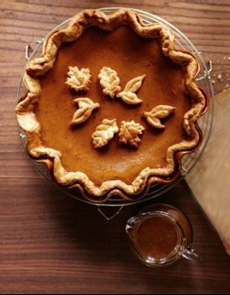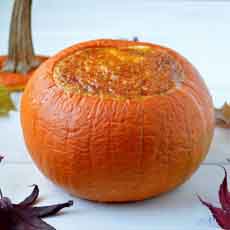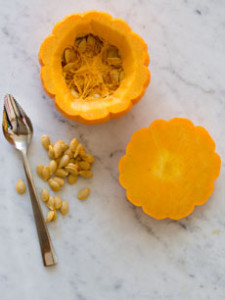Pumpkin Custard Baked In A Pumpkin & The First Thanksgiving
|
We’ll soon celebrate Thanksgiving, a remembrance of a harvest feast that took place 394 years ago. Pumpkin may have been served at the Pilgrims’ first harvest feast, but it wasn’t pumpkin pie. The pumpkin pie we know and love first appears in cookbooks in the early 19th century. After a horrific first winter that saw their community reduced by half, the settlers had yet to construct ovens for baking. Even if there had been butter and shortening to spare, pie crusts wouldn’t have cooked evenly over an open fire. But there may have been a pumpkin custard, which could be cooked in its own vessel—the pumpkin shell. Our tip today is: See if you can fit it into your Thanksgiving menu; and if not, enjoy it in advance of the big day. Before we go on to the recipe below, here are some tidbits from Scholastic.com. The website has a terrific account on the Pilgrims and the first “Thanksgiving” (it wasn’t called that until much later). It expands on snippets taught in school and follows the dual stories of both the Pilgrims and the Wampanoag natives who helped them. The re-enactment videos and photography bring the story to life in a fresh new way. If some family and guests have an hour to kill on Thanksgiving Day, send everyone to the site. It will make the feast so much more meaningful. The Pilgrims, 102 adults and children set sail for Virginia on September 6, 1620. The Mayflower was thrown off course by storms, and landed at Cape Cod 56 days later, on November 11th. The party made their way to the settlement they called Plimouth as winter set in, arriving on Christmas Day. Already weakened by their travel voyage, half of the passengers failed to survive the first few months of a bitter winter. |
|
|
|
During those winter months, it was very difficult to find food and build shelters. Fortunately, the local native people, called Wampanoag, shared their knowledge and helped the colonists survive. Ten months after they arrived the settlers had constructed seven cottages, a common meeting house and three storehouses for the food from their first harvest. The Wampanoag Squanto taught the settlers how to plant native crops like corn and squash. Our national holiday commemorates the feast held in the autumn of 1621 to celebrate the colony’s first successful harvest. It was considered a harvest celebration, and was not called Thanksgiving. The “thanksgiving” concept was applied in the 19th century by scholars studying that period; and the Thanksgiving holiday, setting the last Thursday of November “as a day of Thanksgiving and Praise,” was proclaimed by President Abraham Lincoln in 1863. What did they eat? There’s only one surviving written account of the feast, which mentions neither turkey nor pumpkin, although we know both were plentiful locally. There were no cranberries† and no potatoes, mashed or sweet. Here’s what we do know: *The Native Americans probably couldn’t sweeten them enough to be tasty. Instead, they used cranberries for red dye. |
||
 [3] A traditional pumpkin pie, made in a pie plate with a crust, didn’t appear until the early 19th century. This pie is decorated with small cookies in seasonal shapes (photo © Williams Sonoma).
|
RECIPE: PUMPKIN CUSTARD, BAKED IN A PUMPKIN
According to some accounts, the English settlers hollowed out pumpkins and filled the shells with milk, honey and spices to make a custard. They baked the filled pumpkin in the hot ashes of the fireplace. You, fortunately, have an oven. This recipe creates an impressive dessert that happens to be gluten free. You can also make a savory custard version to serve as a side. Here’s an assortment of savory custard recipes. Note that this isn’t “pumpkin custard” but a conventional custard baked inside a pumpkin. You can make a pumpkin custard by adding pumpkin purée to the custard recipe. Here’s one pumpkin custard recipe; there are many others online. ______________ 1. PREHEAT the oven to 400°F. Prepare the pumpkin as if preparing a jack-o-lantern: Cut off the top leaving the stem intact and scoop out the seeds and pulp. Scoop out enough pulp (pumpkin flesh) for the custard, while leaving a border of pulp to serve along with the finished custard. Place the large bottom portion on a baking sheet. Reserve the top (stem end) for later. 2. COMBINE the sugar, eggs and vanilla in a mixing bowl and whisk until combined. Add the heavy cream, cornstarch and salt and whisk until fully combined. Pour the mixture into the prepared pumpkin, leaving a 3/4-inch space between the filling and the top of the pumpkin. Bake for 15 minutes; then cover the top of the pumpkin loosely with foil and bake another 15 minutes. |
|
|
3. LOWER the oven temperature to 375°F, place the top of the pumpkin on the tray and continue to bake for another 15 minutes. Remove the foil and bake an additional 30 minutes, or until a knife inserted into the custard comes out almost clean. 4. TURN off the oven, allow the pumpkin to cool for an hour, then place it a refrigerator or in your cold garage, loosely covered with plastic wrap or foil. Allow the custard to set 6 hours or overnight. This is a good recipe to assign to a guest, since if you’re making the rest of the dinner, you (a) have your hands full and (b) your fridge is packed. 5. TO SERVE: Scoop the custard into dessert bowls, scraping the sides to include some of the baked pumpkin.
|
||


